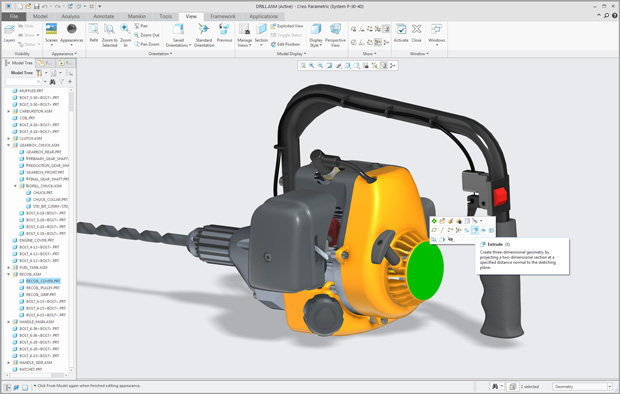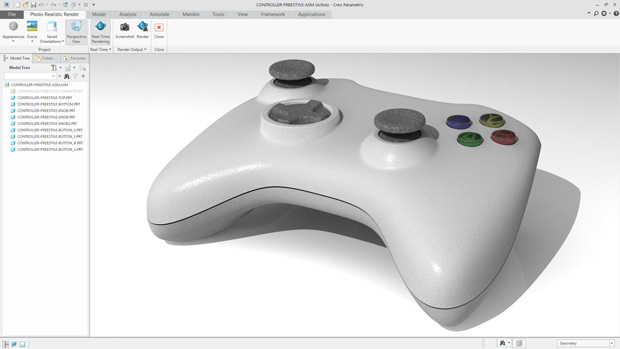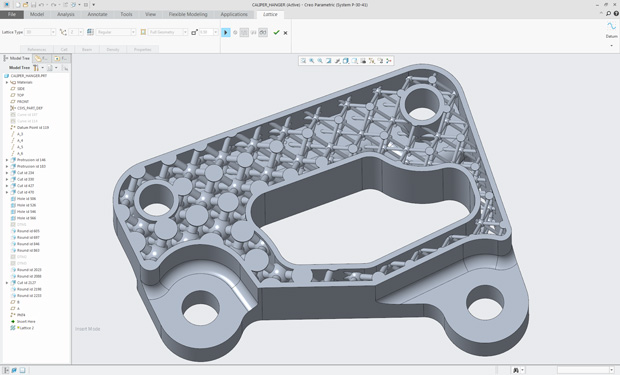
For productivity, Creo 4.0 has context-specific editable command menus. Image courtesy of PTC.
Latest News
November 23, 2016
In today’s design workflow, engineers must adapt to changing design requirements and industry trends. This is evident in the upcoming release of Creo, which is integrating tools for both smart products and additive manufacturing, as well as hundreds of new productivity enhancements across the board. CAD users will be able to download the software next month.
 Creo 4.0’s rendering capabilities are powered by KeyShot, providing more materials and rendering options. Image courtesy of PTC.
Creo 4.0’s rendering capabilities are powered by KeyShot, providing more materials and rendering options. Image courtesy of PTC.“Creo 4.0 sees [PTC] really providing solutions to address the need of transformation in business and technology,” says Paul Sagar, VP of Product Management. He adds that the main goal of this release is to help engineers create validated, optimized designs faster.
Design Standards
As the way that engineers interact with their designs evolves, more teams are finding themselves faced with 3D data management and design as it becomes the new standard. Creo 4.0 has updated authoring capabilities that include the latest ASME and ISO standards and an intelligent GD&T (geometric dimensioning and tolerancing) parametric extension. In being able to add these standards and verify GD&T specifications, engineers ensure manufacturability of their designs.
As 3D designs become more complex, engineers are finding new ways to showcase their design beyond the engineering department. Creo 4.0 launches a rendering engine that is powered by KeyShot, enabling real-time render viewing and direct importing.
“Users will now have an unmatched rendering experience allowing faster creation of product imagery throughout the product development cycle,” Sagar says.
For even more realism, Creo 4.0 also sees a connection with Vuforia, so that engineers can publish an augmented reality (AR) experience directly from the CAD software.
Productivity
Concept design has been a large focus throughout Creo’s history, and 4.0 brings an update to freeform/subdivisional modeling capabilities. Sometimes, engineers use tools such MODO or 3D Studio Max for this type of early design work, Sagar says, but rarely are able to integrate the geometry data into a CAD program. Now, these subdivisional meshes can be directly imported into Creo and reconstructed as a restyle feature. “So you get all the exact same geometry, but now you’ve got it inside Creo as a fully editable model. There’s no need to reconstruct that information,” Sagar says.
Beyond conceptual design stages, Creo has extended its direct modeling capabilities for sheet metal applications, and introduced sketch-based feature workflows and intelligent mirroring. Ultimately, these updated tools are intended to help the user more easily, quickly and cleanly interact with their designs, while being able to reference already integrated data, according to Sagar.
Keeping efficiency in mind, the user interface sees a refresher through a new, customizable mini-toolbar that contains context-sensitive demands as well as a full-screen design view. By being able to access to a WYSIWYG mini-toolbar, Sagar notes, users spend design time directly interacting with the geometry instead of feature toolbars. “Engineers are now basically interacting with the geometry,” he says. “Everything is done on the geometry itself … this eliminates the need to travel up to the ribbon or model tree on a regular basis.”
Smarter Software
Since its launch of ThingWorx, PTC has been diving more deeply into the IoT (Internet of Things) market with software solutions that can help engineers gather, identify and integrate data into their designs. This Creo release signifies a step forward for the digital twin model, with tighter connection to ThingWorx and tools for adding sensors into CAD models.
Creo Product Insight, which will be available next year, will allow users to connect to Creo through ThingWorx to real sensors in the field, get those sensor readings and design against specific collected readings. “It will allow [users] from the start to design into the product the data streams that [they] want from the product when it actually goes into the field,” Sagar explains.
Adding Additive
As additive manufacturing is used more and more for end-use manufacturing, engineers are going to need software that provides more than machine compatibility. Creo 4.0, according to Sagar, is focusing on the design aspect of additive manufacturing and addressing its necessary design optimization needs.
To do this, Creo now includes a complete workflow for designing, optimizing, validating and checking 3D prints before they move to the printbed. This functionality offers engineers the chance to create 2.5D, 3D and variable lattice structures within their designs as full-defined parametric features. Additionally, the software’s integration with Creo Simulate provides the optimization and validation section of the AM design process.
 Users can now create 2.5D, 3D or variable lattice structures as editable geometry in Creo 4.0. Image courtesy of PTC.
Users can now create 2.5D, 3D or variable lattice structures as editable geometry in Creo 4.0. Image courtesy of PTC.By providing tools to address product complexity and the next generation of engineering, it’s clear that Creo 4.0 is evolving to serve the engineers who use CAD on a daily basis to design for, and integrate, new technologies. “A lot of it comes from customer feedback ... there’s a market drive and market push in additive [manufacturing] and IoT. Creo 4.0 shows that we’re spearheading it in the engineering realm,” Sagar says.
Subscribe to our FREE magazine, FREE email newsletters or both!
Latest News
About the Author
Jess Lulka is a former associate editor for Digital Engineering. Contact her via de-editors@digitaleng.news.
Follow DE






